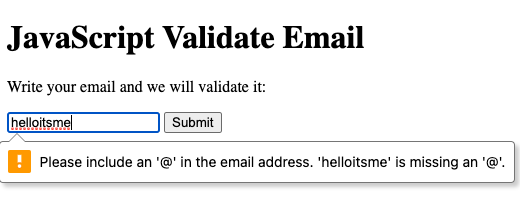4 Ways to Validate an Email with JavaScript 📮

Gaël Thomas
Posted on August 3, 2021

In this article, you will discover three ways to do an email validation with JavaScript!
"An old myth says that you are a web development wizard once you create a contact form! 🧙😄" - Unknown
Email validation using Regular Expressions
The most common way to validate an email with JavaScript is to use a regular expression (RegEx). Regular expressions will help you to define rules to validate a string.
If we summarize, an email is a string following this format:
1. First part of an email
- uppercase and lowercase letters: a-z and A-Z
- digits: 0-9
- hyphens: - (not the last or first character)
- dots: . (not the last or first character)
Note: Some email providers allows email adresses with these character:
! # $ % & ‘ \* + / = ? ^ \ _ \ { | } ~ " ( ) , : ; < > @ [ \ ]. It will depends if you want to accept these mails, but most website rejects them.
2. Second part of an email
- uppercase and lowercase letters: a-z and A-Z
- digits: 0-9
- hyphens: - (not the last or first character)
3. Third part of an email
- uppercase and lowercase letters: a-z and A-Z
- digits: 0-9
- dots: . (not the last or first character)
Here is an email regex expression:
/^[a-zA-Z0-9][\-_\.\+\!\#\$\%\&\'\*\/\=\?\^\`\{\|]{0,1}([a-zA-Z0-9][\-_\.\+\!\#\$\%\&\'\*\/\=\?\^\`\{\|]{0,1})*[a-zA-Z0-9]@[a-zA-Z0-9][-\.]{0,1}([a-zA-Z][-\.]{0,1})*[a-zA-Z0-9]\.[a-zA-Z0-9]{1,}([\.\-]{0,1}[a-zA-Z]){0,}[a-zA-Z0-9]{0,}$/i
In JavaScript, you can use this function for your email validation.
function isEmailValid(email) {
const emailRegexp = new RegExp(
/^[a-zA-Z0-9][\-_\.\+\!\#\$\%\&\'\*\/\=\?\^\`\{\|]{0,1}([a-zA-Z0-9][\-_\.\+\!\#\$\%\&\'\*\/\=\?\^\`\{\|]{0,1})*[a-zA-Z0-9]@[a-zA-Z0-9][-\.]{0,1}([a-zA-Z][-\.]{0,1})*[a-zA-Z0-9]\.[a-zA-Z0-9]{1,}([\.\-]{0,1}[a-zA-Z]){0,}[a-zA-Z0-9]{0,}$/i
)
return emailRegexp.test(email)
}
console.log(isEmailValid('helloitsme@herewecode.io')) // true
console.log(isEmailValid('hello-its-me@herewecode.io')) // true
console.log(isEmailValid('hello.its.me@herewecode.io')) // true
console.log(isEmailValid('helloitsme+test@herewecode.io')) // true
console.log(isEmailValid('.helloitsme@herewecode.io')) // false
console.log(isEmailValid('helloitsme.@herewecode.io')) // false
console.log(isEmailValid('@herewecode.io')) // false
console.log(isEmailValid('helloitsmeherewecode.io')) // false
console.log(isEmailValid('helloitsme@herewecode')) // false
console.log(isEmailValid('d@d.o')) // false
Note: As you can imagine, this Regex isn't homemade. I found it on Stack Overflow; then, I updated it to match the email string format explained above.
Email validation using an Email Validator
If you don't want to create a custom function to validate emails, you can use libraries.
When we type: "email validation library javascript" on Google, the first result is the "email validator" library.
Here is an example of how to use it:
const validator = require('email-validator')
console.log(validator.validate('helloitsme@herewecode.io')) // true
console.log(validator.validate('hello-its-me@herewecode.io')) // true
console.log(validator.validate('hello.its.me@herewecode.io')) // true
console.log(validator.validate('helloitsme+test@herewecode.io')) // true
console.log(validator.validate('.helloitsme@herewecode.io')) // false
console.log(validator.validate('helloitsme.@herewecode.io')) // false
console.log(validator.validate('@herewecode.io')) // false
console.log(validator.validate('helloitsmeherewecode.io')) // false
console.log(validator.validate('helloitsme@herewecode')) // false
console.log(validator.validate('d@d.o')) // false
Email validator is one library among others. You can find a lot of them with different features online.
Email validation using HTML5 input validation
The last way to validate an email is to use an HTML5 email input.
<input type="email" id="email" name="email" placeholder="email" />
Here is an example of an email validation using a simple form:
<!DOCTYPE html>
<html>
<body>
<h1>JavaScript Validate Email</h1>
<p>Write your email and we will validate it:</p>
<form>
<input type="email" id="email" name="email" placeholder="Email" />
<input type="submit" value="Submit" />
</form>
</body>
</html>
As you can see, HTML triggers an error when the email address isn't correct. However, if we type, for example: "helloitsme@herewecode" or "-herewecode.io", the form is valid.
This option is a good feature that you should use when you implement a form on your website. It's suitable for a first validation, but don't forget to validate yourself to avoid issues.
Email validation using an API
As a bonus, you can validate emails using APIs. Here are some companies proposing email validation APIs: SendGrid, MailBoxLayer, Abstract API, etc.
Most of these APIs are not free, but they will provide you some advanced features (ex: check if an email exists).
Hey, you did it!
Thanks for reading until the end! I hope you learned from it! 🎉
➡️ I help web developers improve their skills 💻 If you want to get more tips and resources about web programming -> Follow me on Twitter 🐦

Posted on August 3, 2021
Join Our Newsletter. No Spam, Only the good stuff.
Sign up to receive the latest update from our blog.
Related

September 10, 2023




